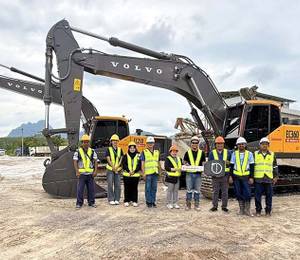Evonik Industries is pursuing a sustainable and cost-effective approach to road construction with Vestenamer, the company’s process additive for the rubber industry. It makes it feasible to process rubber powder from scrap tyres to generate asphalt with rubber content. The recycled material is mixed into road construction bitumen or asphalt to improve the quality of the mixtures and to extend the service life of road surfaces.
In the US, asphalt mixtures containing rubber have been used for decades, said Evonik, and long-term studies have demonstrated a significant improvement in road durability. “The market for elastomer-modified, i.e. rubber-containing, road surfaces has been growing in Europe over the past years as well,” said Frank Lindner, senior business manager for Vestenamer. “The positive properties are obvious since the material significantly reduces cracking, ruts and potholes in the road surface, which in turn extends road service life.”
Rubber-modified bitumen presents another advantage, highlighted Evonik. The rubber powder is frequently used in porous asphalt – also known as low-noise asphalt – that cuts down on traffic noise. Scientific studies have documented that using larger shares of rubber powder in road surfaces can result in a noise reduction of one to two decibels. This is considered highly significant because in human perception, a reduction by 3 dB is comparable to cutting the traffic volume in half.
Evonik further pointed out that every year, a waste volume of some 19.3 mil t of scrap tyres is produced worldwide, including over 3.6 mil t in Europe. Twenty years ago, over half of all scrap tyres were incinerated to generate energy in Germany alone, while only every tenth scrap tyre was processed into granulate. By now, the volume of the latter has caught up with energy-related processing.
Recycling scrap tyres definitely makes environmental sense, asserted Evonik. “Reusing recycled tyres secures valuable resources,” said Thomas Engenhorst, sustainability strategy manager in the Resource Efficiency Segment of Evonik. “Tyres are not classified as waste, but are considered a valuable material, which may not, for example, be disposed of in landfills. This use eliminates the disposal question: Instead of incinerating the tyres, they have another life stage in road traffic – not as part of an engine-powered vehicle, but in the form of an elastomer or rubber powder in the road surface.”
Evonik shared that as part of a test track in the German town of Paderborn, the local road Detmolder Strasse was resurfaced in 2012 in compliance with the objectives of the EU Waste Directive. Fifty percent of the new asphalt mixture consisted of milled material – asphalt granulate – from the old road. The new mixture formulation also included rubber powder and Vestenamer. For every 100 m of track, some 80 scrap tyres were turned into an elastomer-modified road surface, along with recycling the old asphalt.
In addition, a study by the Institute for Energy and Environmental Research in Heidelberg (ifeu) provides further information about the eco-balance, revealed Evonik. Each metric ton of recycled rubber powder saves some 2.7 t of carbon dioxide, which would otherwise be generated during the incineration process.
Evonik added that the emissions of volatile and semi-volatile compounds, including hydrocarbons and sulfur compounds, are also much lower in road surfaces containing rubber than in conventional, polymer-modified asphalt types.
Furthermore, Evonik’s process additive reduces the migration of organic compounds that are washed out by rain and reach the groundwater. As a study conducted by FABES Forschungs-GmbH on behalf of Evonik has documented, the use of Vestenamer reduces the overall groundwater burden.
According to Evonik, in early 2013, the Road and Transportation Research Association added rubber-modified bitumen and asphalt types to German regulations for road construction.
Vestenamer was developed in the late 1970s as a processing aid for the rubber industry. Polyoctenamer, which is produced in the Marl Chemical Park, resolves a number of challenges associated with compounding and processing rubber. It is reportedly used to this day due to its positive characteristics in the interaction with other rubbers. Since road transportation authorities have long been looking for an improved and more durable material, the High Performance Polymers Business Line of Evonik began to conduct extensive research in this area 10 years ago. Since then, Vestenamer has gradually become the unifying element of choice in rubber-modified asphalt.














